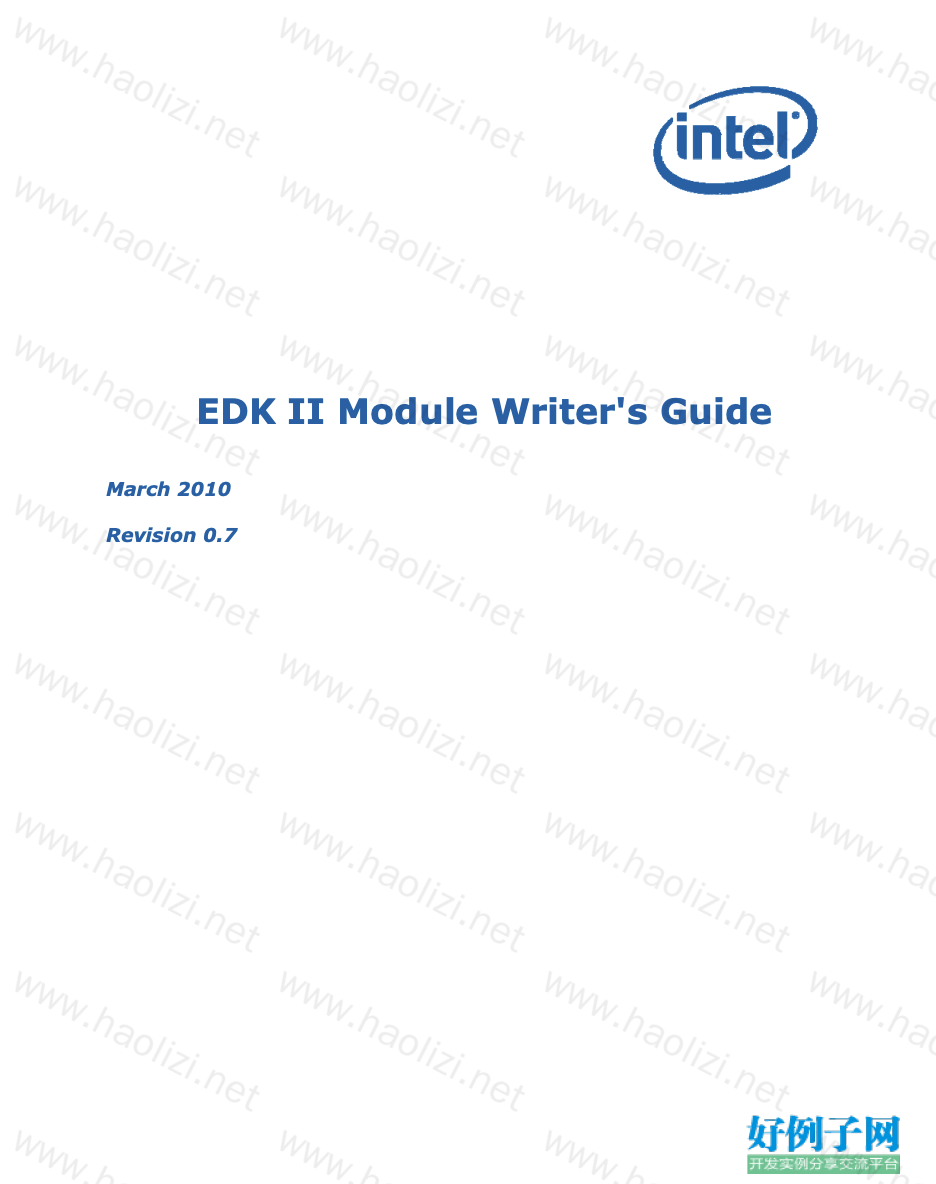实例介绍
This document is a guideline for new EDK II module developers, and provides detailed
instructions on how to develop and build a new module, and how to release with a
package. For information about developing new modules, start with this document.
instructions on how to develop and build a new module, and how to release with a
package. For information about developing new modules, start with this document.

Contents 1 The Basics of EDK II..........................................................................................1 1.1 Overview ..............................................................................................1 1.1.1 Module, Package and Platform.....................................................1 1.1.2 Module Customization ................................................................2 1.1.3 EDK II Development Lifecycle .....................................................2 1.1.4 Build Infrastructure ...................................................................4 1.2 Related References .................................................................................5 1.3 Terms...................................................................................................6 1.4 Target Audience .....................................................................................6 2 An EDK II Package ............................................................................................7 2.1 Introduction ..........................................................................................7 2.1.1 EDK II Packages .......................................................................7 2.1.2 The Package Directory ...............................................................7 2.1.3 Package Declaration File.............................................................8 2.1.4 Package DSC File ....................................................................10 2.2 Manage Package ..................................................................................11 2.2.1 Create Package .......................................................................11 2.2.2 Using a Package......................................................................12 2.2.3 Updating a Package .................................................................12 3 Module Development .......................................................................................16 3.1 What is an EDK II module? ....................................................................16 3.1.1 Module Type ...........................................................................17 3.2 Creating a Module ................................................................................18 3.2.1 Location.................................................................................18 3.2.2 Sample: Module Meta File - INF .................................................19 3.2.3 Adding a Package Dependency ..................................................21 3.2.4 Adding Source Files .................................................................21 3.2.5 Add Library Class References ....................................................22 3.2.6 Adding PCD References ............................................................23 3.2.7 Referencing a Protocol, PPI, or GUID ..........................................25 3.2.8 Adding a Dependency to a Module .............................................26 3.3 Additional Steps for Library Instances .....................................................26 3.3.1 Define Produced Library Class ...................................................26 3.3.2 Define a Library Constructor (Optional) ......................................27 3.3.3 Define a Library Destructor (Optional) ........................................27 3.4 Additional Steps for Driver.....................................................................28 3.4.1 Define a Driver Entry Point .......................................................28 3.5 EDK II Common Library Class ................................................................28 3.6 Module using HII ..................................................................................29 3.6.1 Forms....................................................................................29 3.6.2 Using Unicode Strings ..............................................................33 3.7 Building the module..............................................................................36 3.7.1 Add the module INF in package DSC ..........................................36 3.7.2 Select Library Instances ...........................................................37 iv 3.7.3 Configure PCDs .......................................................................39 3.7.4 Customize Build Options...........................................................42 3.7.5 Build module image .................................................................44 3.7.6 Build EFI Option Rom image .....................................................46 3.7.7 Common build module breaks ...................................................47 3.8 Debugging a Module .............................................................................48 3.8.1 Required steps for debugging a module ......................................48 3.8.2 Basic debugging methods .........................................................49 4 UEFI Applications ............................................................................................50 4.1 Begin with INF file ................................................................................50 4.2 Write UEFI Application Entry Point ..........................................................51 4.3 Get Service Tables................................................................................51 4.4 Communicating with a UEFI driver ..........................................................52 4.4.1 Protocol .................................................................................52 4.4.2 Variable .................................................................................52 5 UEFI Drivers ..................................................................................................53 5.1 Begin With INF File ...............................................................................53 5.2 Write the UEFI Driver entry point............................................................53 5.2.1 Example: APIs in UefiLib ..........................................................54 5.2.2 Example: Entry point to the Abc driver .......................................54 5.3 Get Service Tables................................................................................56 5.4 Communication between UEFI Drivers .....................................................57 5.4.1 Protocol .................................................................................57 5.4.2 Variable .................................................................................57 6 SEC Module....................................................................................................59 6.1 Beginning to Write the INF File ...............................................................59 6.2 Setup Pre-Memory Environment .............................................................59 6.3 Prepare for Data PEI Foundation .............................................................60 6.3.1 EFI_SEC_PEI_HAND_OFF * SecCoreData ....................................60 6.3.2 EFI_PEI_PPI_DESCRIPTOR *PpiList ............................................61 7 Pre-EFI Initialization Modules............................................................................63 7.1 Introduction ........................................................................................63 7.2 Beginning to Write a PEIM INF File ..........................................................63 7.3 Defining a PEIM’s entry point .................................................................63 7.4 Get Pei Services ...................................................................................64 7.5 Communicate between PEIM Modules ......................................................64 7.5.1 PPI........................................................................................64 7.5.2 HOB ......................................................................................65 7.5.3 PCD ......................................................................................66 7.6 Communicate with DXE Modules.............................................................66 7.6.1 HOB ......................................................................................66 7.6.2 Variable .................................................................................66 7.6.3 PCD ......................................................................................67 7.7 Boot Mode...........................................................................................67 7.8 Execution in Place PEIMs .......................................................................68 7.9 Dependency for PEIMs ..........................................................................68 8 DXE Drivers: non-UEFI drivers ..........................................................................70 v 8.1 Beginning with INF File .........................................................................70 8.2 Write DXE Driver Entry Point..................................................................70 8.3 Obtaining Services Tables......................................................................71 8.4 Communication between DXE Drivers......................................................72 8.4.1 Protocol .................................................................................72 8.4.2 Variable .................................................................................74 8.4.3 Dynamic PCD..........................................................................75 8.5 Communication with PEIMs ....................................................................76 8.5.1 HOB ......................................................................................76 8.5.2 Variable .................................................................................78 8.5.3 Dynamic PCD..........................................................................78 8.6 Dependency Expressions .......................................................................78 8.7 Handler for EVT_SIGNAL_EXIT_BOOT_SERVICES ......................................79 8.8 DXE Runtime Driver..............................................................................80 8.8.1 INF File..................................................................................81 8.8.2 Handler for EVT_SIGNAL_VIRTUAL_ADDRESS_CHANGE ................81 8.9 DXE SAL Driver ....................................................................................82 8.9.1 INF File..................................................................................83 8.9.2 Entry Point .............................................................................83 8.10 DXE SMM Driver...................................................................................83 8.10.1 INF File..................................................................................84 8.10.2 Constraints.............................................................................84 Appendix A Dynamic PCD ....................................................................................................87 A.1.1 Class of Dynamic Type.....................................................................................87 A.1.2 When and how to use dynamic PCD ...................................................................88 Tables Table 1 EDK II Module Types ............................................................................17 Table 2 Recommended name convention for module directory ...............................19 Table 3 EDK II supported file extensions ............................................................22 Table 4 INF PCD Section Name .........................................................................24 Table 5 PCD access functions............................................................................25 Table 6 Commonly use library classes ................................................................28 Table 7 Module Entry Point and Service Table Libraries .........................................29 Table 9 Protocols Used to Separate the Loading and Starting/Stopping of Drivers .....53 Table 10. Table Global Variables .......................................................................57 Table 11 Reference to Services Tables for DXE Drivers .........................................71 Figures Figure 1 Conceptual workflow .............................................................................5 Figure 2 Firmware Volume................................................................................16 Figure 3 Temporary Memory Layout...................................................................60
好例子网口号:伸出你的我的手 — 分享!
小贴士
感谢您为本站写下的评论,您的评论对其它用户来说具有重要的参考价值,所以请认真填写。
- 类似“顶”、“沙发”之类没有营养的文字,对勤劳贡献的楼主来说是令人沮丧的反馈信息。
- 相信您也不想看到一排文字/表情墙,所以请不要反馈意义不大的重复字符,也请尽量不要纯表情的回复。
- 提问之前请再仔细看一遍楼主的说明,或许是您遗漏了。
- 请勿到处挖坑绊人、招贴广告。既占空间让人厌烦,又没人会搭理,于人于己都无利。
关于好例子网
本站旨在为广大IT学习爱好者提供一个非营利性互相学习交流分享平台。本站所有资源都可以被免费获取学习研究。本站资源来自网友分享,对搜索内容的合法性不具有预见性、识别性、控制性,仅供学习研究,请务必在下载后24小时内给予删除,不得用于其他任何用途,否则后果自负。基于互联网的特殊性,平台无法对用户传输的作品、信息、内容的权属或合法性、安全性、合规性、真实性、科学性、完整权、有效性等进行实质审查;无论平台是否已进行审查,用户均应自行承担因其传输的作品、信息、内容而可能或已经产生的侵权或权属纠纷等法律责任。本站所有资源不代表本站的观点或立场,基于网友分享,根据中国法律《信息网络传播权保护条例》第二十二与二十三条之规定,若资源存在侵权或相关问题请联系本站客服人员,点此联系我们。关于更多版权及免责申明参见 版权及免责申明



网友评论
我要评论